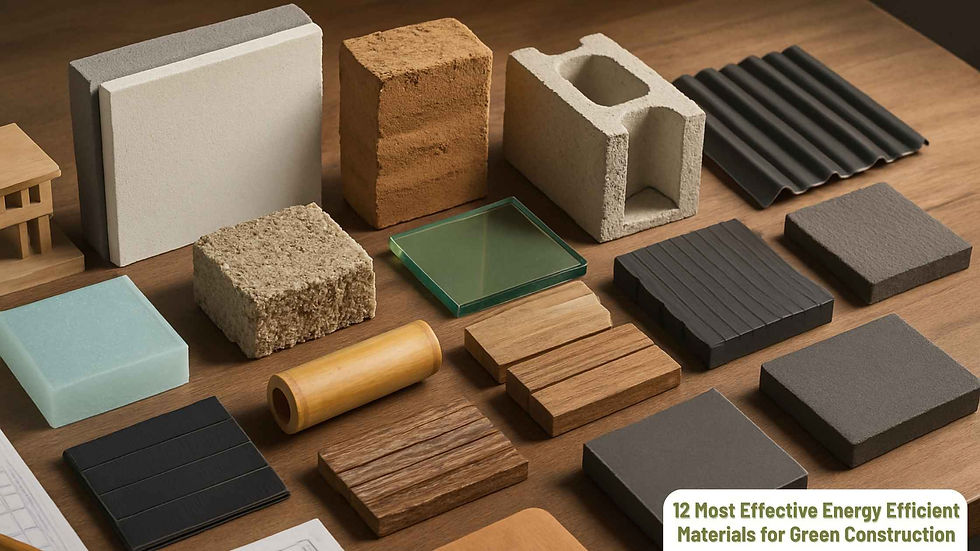12 Most Effective Energy Efficient Materials For Green Construction
- Trupti Doshi

- Aug 11
- 4 min read
Updated: Oct 28

According to a 2022 study by the International Energy Agency (IEA), buildings account for nearly 39% of global carbon emissions, with construction materials and operational energy being the largest contributors. This alarming statistic drives an urgent question: how can we build better, smarter, and more sustainably?
At Auroma Architecture, we’ve answered that call with unwavering commitment. Spearheaded by Architect Trupti Doshi, a pioneer in ecological design based in Pondicherry, India, our projects are more than just structures—they’re intelligent, breathing organisms that serve the environment, not exploit it. And the foundation of that philosophy lies in the choice of materials.
Here’s our in-depth guide to the 12 most effective energy-efficient materials that are reshaping the landscape of green building materials and sustainable construction.
1. Rammed Earth
Trupti Doshi’s flagship project, Sharanam Rural Development Centre, stands as a testimony to the brilliance of energy-efficient materials in construction. Built entirely with rammed earth, this technique involves compacting layers of natural raw materials like soil, chalk, lime, or gravel. The result? A breathable, thermally stable, and visually rich structure that is low on embodied energy and high on aesthetic and environmental value.
2. Fly Ash Bricks
Our work at Auroma French Villaments used fly ash bricks, a byproduct of coal combustion. These bricks not only reduce the need for traditional clay bricks—which deplete fertile topsoil—but also recycle industrial waste, bringing us closer to a circular economy. Plus, they offer superior thermal insulation, reducing the need for mechanical cooling and heating.
3. Lime Plaster
Unlike cement-based plasters that deteriorate over time, lime plaster—revived from ancient techniques—strengthens with age. Architect Trupti Doshi reintroduced Chettinad lime plaster in residential designs, offering not just energy-efficient materials but also antimicrobial and breathable wall solutions that are perfect for tropical climates.
4. Reclaimed Wood
When we use reclaimed wood in our projects, we’re not just reusing material—we’re preserving history. Be it window frames, beams, or furniture, this material brings unmatched character while saving trees and reducing embodied carbon. The Auroma Architecture Office in Puducherry is a stellar example of how reclaimed wood can create warm, inviting workspaces without compromising on sustainability.
5. Bamboo
Strong, fast-growing, and carbon-sequestering—bamboo is nature’s wonder material. Architect Trupti Doshi integrates bamboo in structural frameworks and furniture across various eco-tourism and wellness projects, showcasing it as a lightweight, flexible, and renewable alternative to traditional timber or steel.
6. Compressed Stabilized Earth Blocks (CSEBs)
CSEBs offer the thermal benefits of traditional brick while drastically cutting down on CO₂ emissions. Made by compressing soil mixed with stabilizers like lime or cement, these blocks eliminate the need for high-temperature firing. Sharanam is built almost entirely with CSEBs sourced and produced on-site, making it a model for material localization and sustainability.
7. Cork
Cork is lightweight, moisture-resistant, and an excellent thermal insulator. It’s harvested from the bark of cork oak trees without harming the tree, making it highly renewable. Used in flooring, wall insulation, and soundproofing, cork is gaining popularity in green building materials portfolios worldwide.
8. Hempcrete
A bio-composite made of hemp hurds and lime, hempcrete is not only energy-efficient but also sequesters carbon throughout its life cycle. Architect Trupti Doshi has used this material in pilot studies aimed at testing natural fire resistance and vapor permeability in humid climates.
9. Low-E Glass
Smart glazing techniques using Low-Emissivity (Low-E) glass allow us to regulate heat while maximizing natural daylight. It reduces the dependency on artificial lighting and cooling systems, contributing to significant energy savings in urban constructions like the Westside Complex Trichy.
10. Recycled Metal
Metals like steel and aluminum, when recycled, retain their strength while saving up to 95% of the energy required to produce them from raw materials. Used in frameworks and decorative elements, recycled metal is a staple in Auroma’s industrial and institutional projects.
11. Autoclaved Aerated Concrete (AAC) Blocks
Lightweight and thermally insulating, AAC blocks reduce structural loads and energy consumption. Trupti Doshi uses these in hybrid configurations where thermal mass needs to be complemented by lightweight partitions—especially in multi-storey buildings.
12. Solar Tiles
Solar roof tiles go beyond traditional solar panels to seamlessly integrate energy generation with roofing design. Installed in select Auroma homes Phase 3, these tiles allow buildings to generate their own power while maintaining aesthetic coherence with heritage or regional styles.
Architect Trupti Doshi’s Unique Approach
What sets Architect Trupti Doshi apart is not just her material intelligence but her philosophy—buildings should behave like trees. She designs homes as mothers, schools as teachers, and workspaces as entrepreneurs. Her projects breathe, respond, and evolve with the users who inhabit them.
Whether you’re building a home, a retreat, a school, or a commercial space, the selection of energy-efficient materials plays a pivotal role. These choices define not just performance but the soul of the space. At Auroma Architecture, we make each of these decisions count—with you.
Book a Consultation
Ready to build with conscience and creativity? Book a consultation with Architect Trupti Doshi today by filling out the form at https://www.auromaarchitecture.com/contact-us. Our team will schedule the appointment and guide you on your path to sustainable living.
Your future deserves more than concrete boxes. It deserves a space that nurtures you, your community, and the Earth.


.webp)








